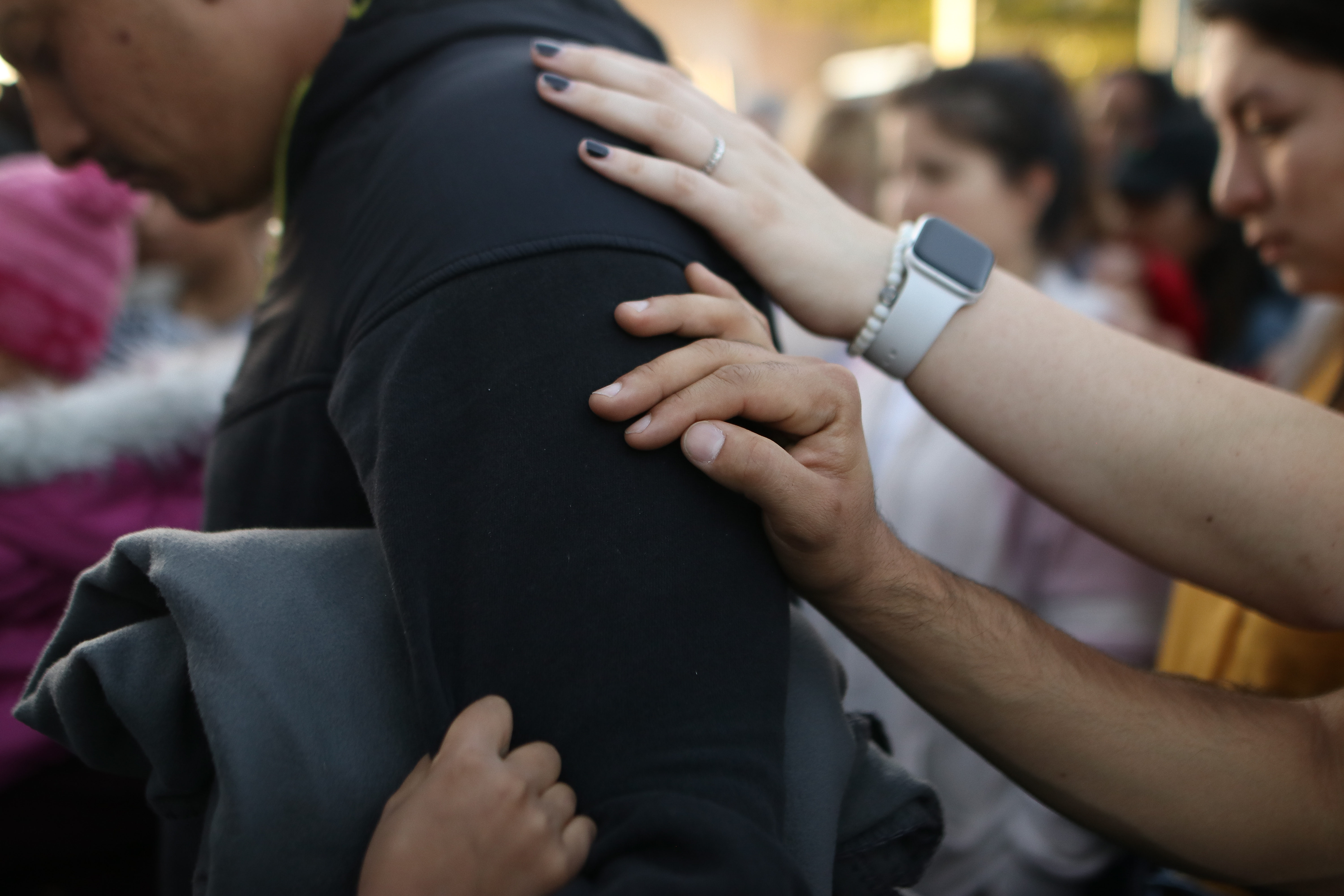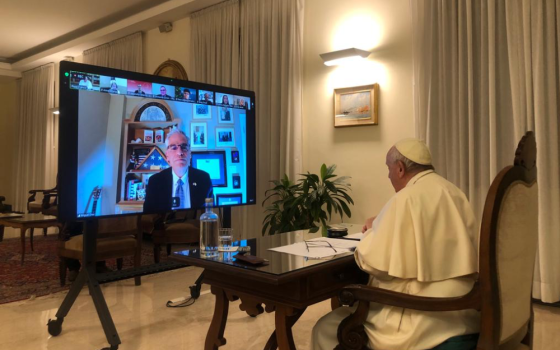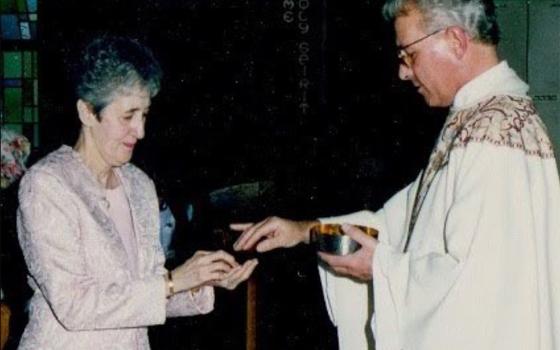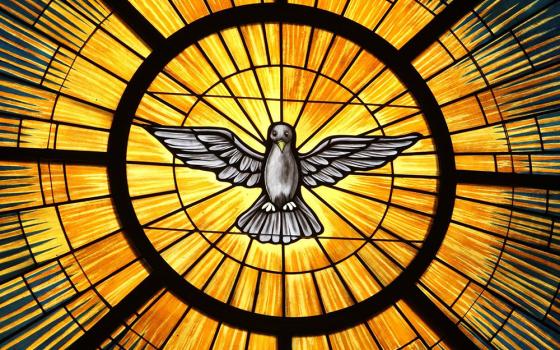
eople pray in Juarez, Mexico, before crossing the Lerdo International Bridge into El Paso, Texas, Oct. 12, 2019. The bridge crossing was a binational public action that was part of an Oct. 11-13 pilgrimage and teach-in held in El Paso, Texas, sponsored by the Latinx Catholic Leadership Coalition, in collaboration with Hope Border Institute. (CNS photo/Jesus Rosales)
On the dining room and kitchen walls in my parents' apartment hung a travelogue of my various journeys, narrated through gifts of decorative plates. From New Orleans to Athens, Hawai'i to Puerto Rico, my Mom mapped a world that memory could revisit. Tucked between Barcelona and London was a souvenir of El Paso-Ciudad Juárez, a small colorful hand-painted clay plate. I had purchased it on the southern side of a border that could not divide two sister cities sharing a bi-national reality. With an image of fiesta, the plate depicts an ordinariness of life that is not alien to either city.
I bought that plate in the summer of 2001 during my first visit to the Texas-México border. For many of us Latin@́ theologians, an invitation to teach at the Tepeyac Institute was hard to resist. Tepeyac is a bilingual instituto, founded in 1988 and dedicated to the ongoing pastoral and theological formation of the laity in the Diocese of El Paso. Numbered among the objectives of the summer sessions was a commitment to "teach participants to critically reflect on the importance of the iglesia mestiza in our border reality as our context for credible ministry." We were all participants in this theological education at the border — professors, especially those of us who were outsiders, learned more than we could ever teach our local students.
El Pasoans of all ages schooled us in the particularities of la vida on this idiosyncratic section of an almost 2000 mile long border that crosses four states and spans a distance from the Pacific Ocean to the Gulf of Mexico. Even then, 18 years ago, just months before the events of September 11th, I saw the fruits of racist and xenophobic policies that disproportionally placed border communities and migrants on both sides at risk economically, educationally, socially and in terms of access to quality health care. At the same time I witnessed robust local social ministries resisting injustice compassionately and prophetically through service and activism, an El Paso tradition that continues to this day.
As a Latin@́ theologian from another borderland, New York City, I have never forgotten the lessons learned or the gracious hospitality extended in my time as a guest in El Paso. More importantly, over the years my experiences of distinctive southwestern U.S.A. borderlands like El Paso-Juárez and San Diego-Tijuana have necessarily complicated my own theologizing on space, place and people on the move. In these complex and contested spaces, I came to understand more deeply one set of roots that ground Latin@́ theologies, commitments articulated by several authors in the classic 1995 volume Mestizo Christianity: Theology from the Latino Perspective edited by El Paso's own Arturo Bañuelas.
Advertisement
A quarter of a century before Pope Francis would urge theologians to not settle for a desktop or office theology and remind us that our "place for reflection is las fronteras, the borderlands," Bañuelas communicated a foundational insight of Latin@́ theologizing.
"[T]heology will not emanate from ivory-tower abstract positions, but from engagement with other Hispanos articulating their struggles and hopes for liberation. Immersed in the Hispanic reality of oppression, these theologians understand how their cultural bias influences their theological presuppositions. They admit the non-neutrality of their theology since their common project, their teología de conjunto, is the liberation of Hispanics as part of God's salvific plan for a new humanity" (73)
Such theologizing respects the popular faith of the people expressed in practices that were not superstitious but in fact are survival strategies and sources of theology. Among the most cherished image, especially but not exclusively by Mexican Americans, is Nuestra Señora de Guadalupe. Virgilio Elizondo, often referred to as a father of Latin@́ theology, saw Guadalupe as the Mother of the New Creation, who "is calling for a new temple that will be sacred precisely because segregation and discrimination will have no place there." (129)
Such theologizing needed to engage across disciplines in order to investigate more deeply and critically slices of lo cotidiano, daily lived experience. The tools of social analysis, critical race theory, postcolonial critique, culture studies, border studies, migration studies, among others, were and still are deployed by subsequent waves of Latinx theologians. They serve as means to dismantle toxic theological and biblical interpretations that sustain white supremacy, colonization, violence, xenophobia and racism.
In the migrations of peoples, in embodied biological and cultural hybridity, in the ambiguity of borderlands, Latin@́ theologians have long, publicly and consistently found christological, eschatological and ethical significance with pastoral and political implications. El Paso alone has produced at least seven Latin@́ Catholic theologians whose scholarship carries this DNA, yet ever pushes and prods in creative new directions.
Within this context, I read the most recent pastoral letter Night Will Be No More by Bishop Mark Seitz of El Paso. It was refreshing to see that the letter reflected a spirit of pastoral en conjunto: "After prayer and speaking with the People of God in the Church of El Paso, I have decided to write this letter on the theme of racism and white supremacy." (4) The timeliness of a white bishop calling out white supremacy from his location as a pastor on a militarized border accompanying an overwhelmingly Latin@́ community reeling from a targeted massacre cannot be underestimated. Situating the current crisis within a greater centuries-old tapestry also marked by violence and racism is helpful, especially for readers who might be unaware of the history of the land and its people. In these precarious days when a prophetic tweet by a Latino bishop causes an uproar and too many of our bishops opt out of speaking truth to power, Seitz's pastoral signals episcopal accountability.
Throughout the document I recognized clear traces and echoes of Latin@́ theologies. It would have been helpful for readers to have access to those sources and citations as well. Latin@́ theological and biblical scholarship, forged en las luchas, in the struggles that impact our peoples' very lives, too often remains undocumented or uncited, even though it is and has been readily accessible in various online venues, scholarly and pastoral publications. Commentators on the letter should also recognize that for over four decades Latin@́ theologians have articulated the urgent matters that are at stake in the borderlands. As important as it is to note who is present as resource, it is equally an obligation to call out the omissions. Theologizing on and from borderlands, migrations and diasporas is a strand in the DNA of Latin@́ theologies and biblical studies, in part because these experiences are embedded in the daily lived reality of the interpreters and the communities we accompany—in other words it's personal!
[Carmen M. Nanko-Fernández is professor of Hispanic theology and ministry, and director of the Hispanic Theology and Ministry Program at Catholic Theological Union (CTU) in Chicago. The author of Theologizing en Espanglish (Orbis), she is currently completing ¿El Santo?: Baseball and the Canonization of Roberto Clemente (Mercer University Press).]
Editor's note: We can send you an email alert every time a Theology en la Plaza column is posted to NCRonline.org. Go to this page and follow directions: Email alert sign-up.








